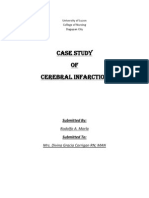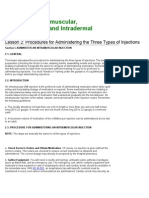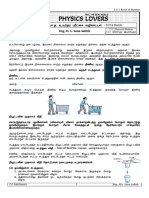Name
Name
Uploaded by
lemuel_queCopyright:
Available Formats
Name
Name
Uploaded by
lemuel_queCopyright
Available Formats
Share this document
Did you find this document useful?
Is this content inappropriate?
Copyright:
Available Formats
Name
Name
Uploaded by
lemuel_queCopyright:
Available Formats
Name:
SET A
1. Dystocia A. Abnormal, long or difficult labor or delivery 2. Uterine Dystocia B. Dysfunctional uterine contractions 3. Amniotomy C. Artificial rupture of the amniotic sac 4. Cervical Ripening D. Softening and effacing of the cervix 5. Hypetonic uterine contractions E. Increase in frequency of contractions, but intensity is decreased 6. Cephalopelvic Disproportion F. Large baby or small pelvis 7. Version G. Alteration of fetal position by abdominal or intrauterine manipulation 8. Amnioinfusion H. Infusion of warm saline into the uterine cavity 9. Forceps delivery I. Instrument placed over vertex of head usually applied after crowning 10. Vacuum extraction J. Disk shaped cup placed over vertex of head and suction applied 11. Episiotomy K. Surgical incision to allow more room for delivery 12. Cesarean Delivery L. Delivery through an incision 13. Prolonged Labor M. Labor lasting more than 18 - 24 hours 14. Failure to Progress N. Unable to make changes in dilation or effacement 15. Precipitous labor and delivery O. Labor that last less than 3 hours, unexpected fast delivery 16. Cord Prolapse P. Protrusion of the umbilical cord through the cervical canal 17. PROM Q. Spontaneous rupture of the membranes 18. Preterm Labor R. Labor that occurs after 20 weeks but before 37 weeks 19. Amniotic Fluid Embolism S. Escape of amniotic fluid into the maternal circulation 20. Induction of Labor T. Stimulation of uterine contractions before the onset of labor
Name:
SET B
1. Dystocia A. Abnormal, long or difficult labor or delivery 2. Uterine Dystocia B. Dysfunctional uterine contractions 3. Amniotomy C. Artificial rupture of the amniotic sac 4. Cervical Ripening D. Softening and effacing of the cervix 5. Hypetonic uterine contractions E. Increase in frequency of contractions, but intensity is decreased 6. Cephalopelvic Disproportion F. Large baby or small pelvis 7. Version G. Alteration of fetal position by abdominal or intrauterine manipulation 8. Amnioinfusion H. Infusion of warm saline into the uterine cavity 9. Forceps delivery I. Instrument placed over vertex of head usually applied after crowning 10. Vacuum extraction J. Disk shaped cup placed over vertex of head and suction applied 11. Episiotomy K. Surgical incision to allow more room for delivery 12. Cesarean Delivery L. Delivery through an incision 13. Prolonged Labor M. Labor lasting more than 18 - 24 hours 14. Failure to Progress N. Unable to make changes in dilation or effacement
15. Precipitous labor and delivery O. Labor that last less than 3 hours, unexpected fast delivery 16. Cord Prolapse P. Protrusion of the umbilical cord through the cervical canal 17. PROM Q. Spontaneous rupture of the membranes 18. Preterm Labor R. Labor that occurs after 20 weeks but before 37 weeks 19. Amniotic Fluid Embolism S. Escape of amniotic fluid into the maternal circulation 20. Induction of Labor T. Stimulation of uterine contractions before the onset of labor
You might also like
- Music Theory For Electronic Music ProducersDocument247 pagesMusic Theory For Electronic Music ProducerswillibongaNo ratings yet
- Chapter 015 PSDocument11 pagesChapter 015 PSJann ericka Jao100% (1)
- Canada Visa FormDocument4 pagesCanada Visa Formlemuel_queNo ratings yet
- TPR SheetDocument1 pageTPR Sheetlemuel_que33% (3)
- Case Study Cerebral InfarctDocument11 pagesCase Study Cerebral InfarctRodel MorlaNo ratings yet
- Distosia Kelompok 1Document10 pagesDistosia Kelompok 1Kamu SiapaNo ratings yet
- Rationalization 1st PeriodDocument14 pagesRationalization 1st PeriodJenny Agustin FabrosNo ratings yet
- Various Childbirth PracticesDocument11 pagesVarious Childbirth PracticesFarheen khan100% (1)
- Obstetric EmergenciesDocument366 pagesObstetric EmergenciesYego EdwinNo ratings yet
- Maternal 20 12Document10 pagesMaternal 20 12Nell PansaonNo ratings yet
- MCN ObDocument7 pagesMCN ObJoshua SaelNo ratings yet
- Complication of Labor Hand OutDocument28 pagesComplication of Labor Hand Outdanicamarieparado018No ratings yet
- Patient TeachingDocument2 pagesPatient Teachingapi-394684626No ratings yet
- IDPS Chapter 15Document10 pagesIDPS Chapter 15002No ratings yet
- Evolve Key Points and Questions For Test 2 Maternal Child CareDocument104 pagesEvolve Key Points and Questions For Test 2 Maternal Child CareHeather100% (2)
- Prolonged Labour - Print DR AdilDocument2 pagesProlonged Labour - Print DR AdilAri Puji AstutiNo ratings yet
- OB COMPRE PRELIM 2019 Key 1Document27 pagesOB COMPRE PRELIM 2019 Key 1Zhy Caluza57% (7)
- Problems With The PassengerDocument5 pagesProblems With The PassengerJuviely PremacioNo ratings yet
- Cesarean Birth (Breech Presentation)Document5 pagesCesarean Birth (Breech Presentation)Dave Noel AytinNo ratings yet
- NUR 194 P2 Examination W Ratio AKDocument29 pagesNUR 194 P2 Examination W Ratio AKRia AtilloNo ratings yet
- Inbound 5076404272819050820Document21 pagesInbound 5076404272819050820Retiza EllaNo ratings yet
- NS 1 Quiz 3 Ob 1Document17 pagesNS 1 Quiz 3 Ob 1christianmagbalon13No ratings yet
- Maternal Self Care Education Needs - Teaching PlanDocument5 pagesMaternal Self Care Education Needs - Teaching PlanKim Justin InfantadoNo ratings yet
- Prolonged Labour: (Dystocia) : ObjectivesDocument9 pagesProlonged Labour: (Dystocia) : ObjectivesuouoNo ratings yet
- Destructive OperationsDocument23 pagesDestructive OperationsDeepti KukretiNo ratings yet
- Intrapartum 2003Document76 pagesIntrapartum 2003Karla Jane100% (2)
- SSG 1Document4 pagesSSG 1Henie Louise HinanayNo ratings yet
- Complications of PregnancyDocument22 pagesComplications of PregnancyDon Oliveros ÜNo ratings yet
- Maternal AssignmentDocument3 pagesMaternal AssignmentJoule PeirreNo ratings yet
- Abnormal LabourDocument116 pagesAbnormal Labourtum chrisNo ratings yet
- Inversion Utery - A Cse ReportDocument27 pagesInversion Utery - A Cse ReportJaromeKosmanNo ratings yet
- Intrapartum ProblemsDocument78 pagesIntrapartum ProblemsPaulineNo ratings yet
- Family Experiencing A Complication For Labor and During Cesarean Birth1Document4 pagesFamily Experiencing A Complication For Labor and During Cesarean Birth1ace.evanzNo ratings yet
- Cesarean DeliveryDocument6 pagesCesarean DeliveryShella Marie UsquisaNo ratings yet
- MCN 1 Answer and RationaleDocument4 pagesMCN 1 Answer and RationaleJmj RCNo ratings yet
- Uterine AtonyDocument3 pagesUterine AtonyArsheina Paradji100% (1)
- Case Simu 113Document4 pagesCase Simu 113Princess Levie CenizaNo ratings yet
- The Diagnosis of PregnancyDocument76 pagesThe Diagnosis of PregnancyCnette S. LumboNo ratings yet
- Abnormal Labour & Obstetric Emergency (Autosaved) - 1Document449 pagesAbnormal Labour & Obstetric Emergency (Autosaved) - 1Moses TarkoNo ratings yet
- CHAPTER 2 High Risk Labor and DeliveryDocument26 pagesCHAPTER 2 High Risk Labor and Deliveryjacobprince0016No ratings yet
- Prepared by Marjorie Galicia Romano Clinical InstructorDocument106 pagesPrepared by Marjorie Galicia Romano Clinical InstructorMarjorie Galicia Romano-AndalisNo ratings yet
- Problems of The PassengerDocument11 pagesProblems of The PassengerShanon France100% (1)
- Cephalopelvic DisproportionDocument1 pageCephalopelvic DisproportionWhinet Jojo TerunaNo ratings yet
- Lesson 5Document13 pagesLesson 5Kyla GambanNo ratings yet
- Stages of LaborDocument4 pagesStages of Laborabrnrd56No ratings yet
- Eech & Abnormal PresentationsDocument14 pagesEech & Abnormal Presentationsasri khazaliNo ratings yet
- AbnormalDocument9 pagesAbnormalDahabu AliNo ratings yet
- Obstructed LaborDocument17 pagesObstructed LaborOuma OgomboNo ratings yet
- Intrapartum PeriodDocument19 pagesIntrapartum Periodanon_915924422No ratings yet
- OB Sample QuizDocument2 pagesOB Sample QuizYaj CruzadaNo ratings yet
- 4 Ob ExamDocument9 pages4 Ob ExamKim Ramos100% (1)
- Mine RashDocument4 pagesMine RashShAne Annahari BakilNo ratings yet
- Disimpaction of Fetal HeadDocument20 pagesDisimpaction of Fetal Headrake sardevaNo ratings yet
- Types of Birth DeliveryDocument4 pagesTypes of Birth DeliveryAijem RyanNo ratings yet
- Breech PresentationDocument46 pagesBreech PresentationushaNo ratings yet
- OB Stages of Labor and Care in The Stages of Labor With VideoDocument45 pagesOB Stages of Labor and Care in The Stages of Labor With VideodsmagallanesNo ratings yet
- Midwifery Board ExamsDocument18 pagesMidwifery Board Examsfeyt legaspiNo ratings yet
- LaborDocument94 pagesLaborLany Cardente PascuaNo ratings yet
- Cephalopelvic DisproportionDocument5 pagesCephalopelvic DisproportionMaria Donabella OngueNo ratings yet
- Abnormal LabourDocument4 pagesAbnormal LabourYavani KulasinghamNo ratings yet
- Client With High-RiskDocument170 pagesClient With High-RiskLongyapon Sheena Stephanie100% (2)
- Chapter 023 PSDocument11 pagesChapter 023 PSjimwelluismNo ratings yet
- C-Section (Suparna & Aanchal)Document16 pagesC-Section (Suparna & Aanchal)bhaveshchaudhary4343No ratings yet
- NCM 102Document8 pagesNCM 102lemuel_que100% (2)
- NCM 102Document8 pagesNCM 102lemuel_que100% (2)
- Elective I: Hospice Palliative CareDocument3 pagesElective I: Hospice Palliative Carelemuel_que50% (2)
- LymphaticDocument52 pagesLymphaticlemuel_queNo ratings yet
- An Orthopedic Treatment That Involves Placing On A Limb, Bone or Muscle Group Using Variety ofDocument22 pagesAn Orthopedic Treatment That Involves Placing On A Limb, Bone or Muscle Group Using Variety oflemuel_que100% (2)
- Virus Structure and Method of InvasionDocument9 pagesVirus Structure and Method of Invasionlemuel_queNo ratings yet
- CastDocument17 pagesCastlemuel_que100% (2)
- Elective I: Hospice Palliative CareDocument3 pagesElective I: Hospice Palliative Carelemuel_que50% (2)
- Administer IntramuscularDocument17 pagesAdminister Intramuscularlemuel_queNo ratings yet
- Everything You Need To Know About The Conjugation of "Essere" in ItalianDocument1 pageEverything You Need To Know About The Conjugation of "Essere" in ItalianTatjana MilosavljevicNo ratings yet
- P79 MBA Home Assignment 2021-2022 Sem IDocument5 pagesP79 MBA Home Assignment 2021-2022 Sem IAnil TekaleNo ratings yet
- Pepsico'S Unsolicited Idea PolicyDocument1 pagePepsico'S Unsolicited Idea PolicyFelipe MachadoNo ratings yet
- Options and Corporate Finance: Multiple Choice QuestionsDocument58 pagesOptions and Corporate Finance: Multiple Choice Questionsbaashii4No ratings yet
- Mathematics: First Quarter - Week 4Document6 pagesMathematics: First Quarter - Week 4MARIE GRACE APARRENo ratings yet
- Introduction of Fluid Mechanics CUDocument38 pagesIntroduction of Fluid Mechanics CUABDELRHMAN ALINo ratings yet
- Zamboanga City: Orgullo de MindanaoDocument35 pagesZamboanga City: Orgullo de MindanaoAngelo Mariano De Asis100% (1)
- 2023 2024 Emptech Module 04 Imaging and Design For Online EnvironmentDocument18 pages2023 2024 Emptech Module 04 Imaging and Design For Online EnvironmentHEHENo ratings yet
- BTBT I-Learn Smart World 9 HK1 Unit 2 (HS)Document5 pagesBTBT I-Learn Smart World 9 HK1 Unit 2 (HS)Thư MinhNo ratings yet
- Communication InterfaceDocument10 pagesCommunication InterfaceHarini MNo ratings yet
- 2.3.1.newtons LawDocument18 pages2.3.1.newtons LawdigitalimagentrNo ratings yet
- Logical and Quantitative Techniques Logical and Quantitative TechniquesDocument2 pagesLogical and Quantitative Techniques Logical and Quantitative Techniquesanushkaanand2021No ratings yet
- Present SimpleDocument3 pagesPresent SimpleclarasemitielbNo ratings yet
- Cesarean DeliveryDocument210 pagesCesarean DeliveryJosé Ramírez100% (3)
- Talmakkies Case Judgment Over Magistrate 21.11.2023Document17 pagesTalmakkies Case Judgment Over Magistrate 21.11.2023Krash KingNo ratings yet
- Complete It GuideDocument22 pagesComplete It Guideapi-110348022No ratings yet
- Lesson 22 Henle Second Year LatinDocument2 pagesLesson 22 Henle Second Year LatinJennifer Jones100% (1)
- MK0012 Retail Marketing Fall 10 SolvedDocument22 pagesMK0012 Retail Marketing Fall 10 SolvedDeep Dhar100% (1)
- Malariappt 110313053826 Phpapp01Document12 pagesMalariappt 110313053826 Phpapp01spiderind2No ratings yet
- Hero Cycle ProjectDocument8 pagesHero Cycle Projectapi-357255092No ratings yet
- Micro ParasitesDocument4 pagesMicro ParasitesKrisha Marie BadilloNo ratings yet
- Tajweed English Full Pack Master SheetDocument4 pagesTajweed English Full Pack Master Sheetmaryamhassansaleh4949No ratings yet
- Lok Sewa AayogDocument5 pagesLok Sewa AayogLokraj SharmaNo ratings yet
- NotesDocument5 pagesNotesKorrine FloresNo ratings yet
- Welding Safety Inspection Article UpdatedDocument4 pagesWelding Safety Inspection Article UpdatedChris TeohNo ratings yet
- Yealink SIP-T20P DatasheetDocument2 pagesYealink SIP-T20P DatasheetmartinsNo ratings yet
- Scriptures For Studying and ExamsDocument3 pagesScriptures For Studying and Examsvimon100% (1)
- Roland Factory ResetDocument10 pagesRoland Factory ResetMiguel ReyesNo ratings yet


































































































